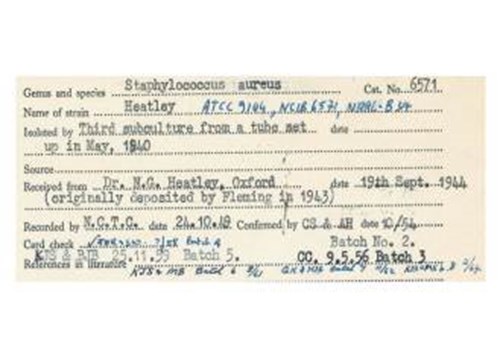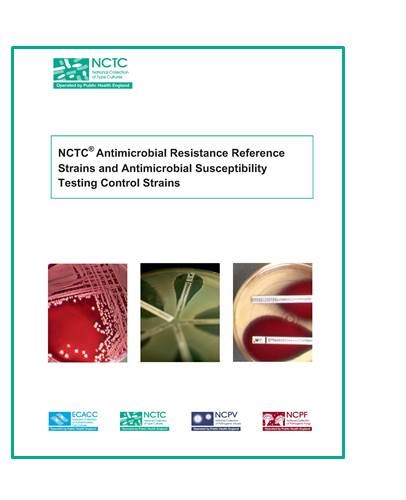NCTC and Antimicrobial Medicine : Past, present and future

The first modern antimicrobial, penicillin, was developed as a therapeutic agent at Oxford University’s Sir William Dunn School of Pathology in the late 1930s and early 1940s. A team led by Sir Howard Florey which included Alexander Fleming, Ernst Chain, Margaret Jennings and Norman Heatley would characterise penicillin, evaluate its ability to cure infection in humans and pioneer a means of mass production.
Naturally, an aspect of this work involved testing newly cultivated penicillin on grown cultures of species of pathogens it was intended to treat. Adopted into use by Norman Heatley, NCTC 6571 Staphylococcus aureus was added to the NCTC collection by Alexander Fleming in 1943, declaring in a letter that “all of us on the Penicillin Trials are using it”1. When developing a refined and standardised methodology for the assay of the concentration of penicillin by measuring the inhibition of growth of bacterial culture, NCTC 6571 was selected as a standardised test organism, and was already easily available for distribution to the scientific community. The strain quickly became NCTC’s second most highly distributed culture in 1944 and became known colloquially among bacteriologists as the “Oxford Staph” due to its extensive use by Florey’s team.
NCTC 6571 remains one of NCTC’s most highly distributed organisms and most commonly cited strains in the scientific literature. It is frequently used as a control organism for the phenotypic characterization of S. aureus and other Staphylococcal species2, and is included in several of Public Health England’s Standards for Microbiology Investigations3 test procedures as well as an antibiotic susceptible control under BSAC guidelines.
The development of penicillin and other antibiotics revolutionised the treatment of bacterial infection. The advent and spread of bacteria resistant to treatment from a wide range of antibiotics now threatens this, and is one of the 21st Century’s most major global public health challenges. Organisms curated by the National Collection of Type Cultures have not only been used to in the development antimicrobial medicine in use today, but also used to understand how antimicrobial resistance spreads. Research using NCTC’s Murray Collection (a collection of pre-antibiotic era isolates) helped to establish that medically relevant bacteria acquire resistance by the insertion of new genes into existing plasmids rather than by the spread of previously rare plasmids4, and genomic examination of NCTC strains continues to provide insights into the population structure of epidemic lineages and evolution of antibiotic resistant organisms that cause nosocomial infection5.
The diverse collection of species available through NCTC are often used to evaluate novel antimicrobial compounds6, and the collection’s active accessioning programme is continuously adding emerging AMR strains such as the colistin resistant MCR-1 positive NCTC 13846 Escherichia coli strains carrying a wide variety resistance genes are available from NCTC, including quality control strains specified by BSAC, EUCAST, CLSI and the WHO7 for the harmonised measurement of AMR.
NCTC aims to work closely with the scientific community and is constantly appealing to researchers and clinicians for strains that have novel resistance genes, novel mechanisms of resistance or novel resistance phenotypes. Depositing organisms into the National Collection of Type Cultures is a free service. If you have a strain that you think may be of interest to the scientific community or may be valuable in the study of antimicrobial resistance, please contact us.
Related Links
Culture Collections - deposit with us
References
- Fleming, Alexander. Letter to Dr R. St. John Brooks, Curator, NCTC. 9th August 1943
- Kearns AM et al. The 'Oxford Staphylococcus': a note of caution. J Antimicrob Chemother. 2006 Aug;58(2):480-1. Epub 2006 May 30. https://www.ncbi.nlm.nih.gov/pubmed/16735421
- Standards for microbiology investigations (SMI). Available online: https://www.gov.uk/government/collections/standards-for-microbiology-investigations-smi
- Datta N, Hughes VM. Plasmids of the same Inc groups in Enterobacteria before and after the medical use of antibiotics Nature. 1983 Dec 8-14;306(5943):616-7 https://www.ncbi.nlm.nih.gov/pubmed/6316165
- Raven KE et al. Genome-based characterization of hospital-adapted Enterococcus faecalis lineages. Nat Microbiol. 2016 Feb 8;1:15033. https://www.ncbi.nlm.nih.gov/pubmed/27572164
- Yang N. et al. Discovery of Novel Bacterial Cell-Penetrating Phylloseptins in Defensive Skin Secretions of the South American Hylid Frogs, Phyllomedusa duellmani and Phyllomedusa coelestis. Toxins (Basel). 2016 Aug 31;8(9). https://www.ncbi.nlm.nih.gov/pubmed/27589802
- Unemo M et al. The novel 2016 WHO Neisseria gonorrhoeae reference strains for global quality assurance of laboratory investigations: phenotypic, genetic and reference genome characterization. J Antimicrob Chemother. 2016 Nov;71(11):3096-3108. https://www.ncbi.nlm.nih.gov/pubmed/27432602

